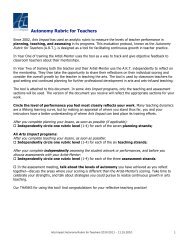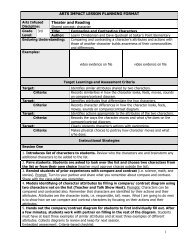Parallel and Perpendicular Lines - Arts Impact
Parallel and Perpendicular Lines - Arts Impact
Parallel and Perpendicular Lines - Arts Impact
- No tags were found...
You also want an ePaper? Increase the reach of your titles
YUMPU automatically turns print PDFs into web optimized ePapers that Google loves.
Draw the map.1. short vertical line segment2. right angle <strong>and</strong> short horizontal line segment3. right angle <strong>and</strong> short vertical line segment4. right angle <strong>and</strong> short horizontal line segment5. right angle <strong>and</strong> short vertical line segment6. Your partner draws the mirror image pathway.Prompts: Check your work. Do you have 5 pairs of parallel lines? Do you have eight pairs ofperpendicular lines? Is your map symmetrical?g. Dance the map. Prompts: If you were the follower for the drawing, you get to decide whatlocomotor movement to perform on your pathway. Imagine your line of symmetry (the fold of yourpaper) as a line on the floor that extends from the front of the room to the back of the room as yourehearse your study. (Note: you may use tape to make lines of symmetry on the floor for studentsto use as a reference, or they can use imaginary lines. A line of symmetry running from the front ofthe room to the back gives the best perspective on the dance studies.) Music: “Travel Notes”:“American Fiddler” #13, “Andean Altitude” #14, “Saharan Campsite” #15, Music for CreativeDance, Volume II.Student: Works with a partner to create the symmetrical pathway map; decides on locomotormovement; rehearses.Embedded Assessment: Criteria-based teacher checklist; criteria-based self-assessment5. Leads performance <strong>and</strong> observation of the students’ symmetrical pathway dances. Askseach duo to find another duo <strong>and</strong> show them their dance. Directs the duo that is observing to draw thepathway they saw danced <strong>and</strong> to label at least two pairs of parallel lines <strong>and</strong> at least two pairs ofperpendicular lines on the Peer Assessment Worksheets. Describes how to notate this on the peerassessment worksheet. Prompts: Observers, draw the pathway map that you saw. You can watch oneof the dancers <strong>and</strong> draw her/his pathway, <strong>and</strong> then when they are done dancing, you can draw themirror image—the dancer’s pathway. Label at least two pairs of parallel lines <strong>and</strong> at least two pairs ofperpendicular lines. You can ask the performers to do their dance twice if it helps you.Performance process notes: Depending on the time <strong>and</strong> space you have available, you might wantto adapt the performing process. You have a few options, the only requirement is that each duocreates <strong>and</strong> performs their pathway map dance <strong>and</strong> notates one other duo’s dance.• As above, half of the class performs in duos at one time, with each duo observing <strong>and</strong> drawing thedance of one other duo, then reversing roles. This strategy requires the largest space.• 2-3 duos perform at a time <strong>and</strong> observers select one of the dances to draw.• One group performs at a time <strong>and</strong> observers select one of the dances to draw. You could choose tohave them draw all the dances, but inform students which drawing will be assessed if they makemore than one drawing.• One group leads the entire class through their dance (follow the leader in two lines). The secondgroup in line peals off <strong>and</strong> draws the map. Continue until all have had a chance to lead <strong>and</strong> draw.(After each duo has had a chance to perform its dance <strong>and</strong> notate one other dance, if time permits,you can ask a few groups at a time to perform for the rest of the class, with audience either justwatching or notating everyone’s dance.)Student: Performs <strong>and</strong> notates.Embedded Assessment: Criteria-based teacher checklist; criteria-based peer assessment6. Facilitates a reflective discussion. Prompts: Performers—How did you translate the pathwaypicture into movement? Did you have certain strategies that helped you create the symmetricalpathway through the space? Audience—where did you see parallel <strong>and</strong> perpendicular lines? What didFourth Grade—Dance <strong>and</strong> Math—<strong>Parallel</strong> <strong>and</strong> <strong>Perpendicular</strong> <strong>Lines</strong>
the performers do to make sure you saw the symmetrical pathway in their dance study? Students—howcan what we learned today by dancing help you in math?Student: Participates in the discussion.Embedded Assessment: Criteria-based teacher checklist; criteria-based self-assessment; criteria-basedclass critiqueWritingClassroomWriting ActivityClassroomActivityARTCo- TeachARTModel/Co- TeachWritingClassroomActivityARTSupportedTeachWritingClassroomActivityWritingClassroomActivityIndependentPracticeWritingWASLBefore next DANCE lesson:Math1. Repeat the BrainDance frequently to reinforce the learning.Math2. Explore the math concepts using your math curriculum.MathIf time is available, explore the concepts in other ways:3. Repeat the Mirror Dance (from <strong>Lines</strong> of Symmetry lesson) with leaders drawingparallel or perpendicular lines.4. Do a “h<strong>and</strong> dance” to help remember parallel or perpendicular lines. Make parallel <strong>and</strong>perpendicular shapes <strong>and</strong> movements with only your h<strong>and</strong>s.Independent Practice: H<strong>and</strong> dance it! Draw it on paper! <strong>Parallel</strong> lines – same distanceapart – never cross! <strong>Perpendicular</strong> lines cross at right angles.Vocabulary Materials <strong>and</strong> Community Resource WA Essential Learnings & Frameworks<strong>Arts</strong>:locomotor movementnon-locomotor movementpathwaysshape<strong>Arts</strong> Infused:flipline segmentlines of symmetryparallelperpendicularslidesymmetricalMuseum Artworks or Performance:Broadway Center for the Performing <strong>Arts</strong>, Tacoma,WA: Do Jump, Peking AcrobatsArt Materials or Performance Materials:CD playerMusic for Creative Dance, Volume IIGeometry DancesdrumBrainDance chartlocomotor <strong>and</strong> non-locomotor movement chartsample pathway mapspaper <strong>and</strong> markersblue painter’s tapepeer assessment worksheetsassessment checklistAEL 1.1 concepts: pathways; parallel <strong>and</strong>perpendicular linesAEL 1.1.2 principles of organization: createsmovement sequencesAEL 1.2 skills <strong>and</strong> techniques: performs sequencesAEL 1.4: audience skillsAEL 2.1 applies creative process: organizes elementsinto a creative workAEL 4.2: dance <strong>and</strong> math connectionMEL 1.3.1 geometric sense: underst<strong>and</strong>s concept ofparallel <strong>and</strong> perpendicular linesMath State FrameworksGrade 4: explains parallel <strong>and</strong> perpendicular lines<strong>and</strong> gives examples to demonstrate themFourth Grade—Dance <strong>and</strong> Math—<strong>Parallel</strong> <strong>and</strong> <strong>Perpendicular</strong> <strong>Lines</strong>
Peer Assessment Worksheet – Symmetrical Pathway MapsName:________________________________ Date:Performers’NamesDraw what you saw: the mirror image pathway the dancers created.Label at least two parallel line pairs <strong>and</strong> two perpendicular line pairs.You can use these symbols. parallel: ⎪⎪ perpendicular: ⊥Fourth Grade—Dance <strong>and</strong> Math—<strong>Parallel</strong> <strong>and</strong> <strong>Perpendicular</strong> <strong>Lines</strong>
ARTS IMPACT—ARTS-INFUSED INSTITUTE LESSON PLAN (YR2-AEMDD)LESSON TITLE: <strong>Parallel</strong> <strong>and</strong> <strong>Perpendicular</strong> <strong>Lines</strong>—Symmetrical Pathway MapsASSESSMENT WORKSHEETStudents1.2.3.4.5.6.7.8.9.10.11.12.13.14.15.16.17.18.19.20.21.22.23.24.25.26.27.28.TotalPercentageDisciplines MATH DANCE AND MATH DANCE AND MATHConceptSYMMETRYPARALLELPERPENDICULARThe MapSYMMETRYPARALLELPERPENDICULARThe DanceDraws a mirror imagepathway map,incorporating 5 pairs ofparallel lines <strong>and</strong> 8 pairsof perpendicular linesWith a partner, movesalong a mirror imagelineSYMMETRYPARALLELPERPENDICULARThe ObservationDraws the symmetrical pathway of thedance observed <strong>and</strong> labels:at least two pairsof parallel linesat least two pairsof perpendicularlinesTotal4Criteria-based Reflection Questions: (Note examples of student reflections.)Self-Reflection: How can what we learned today by dancing help you in math?Peer to Peer: Where did you see parallel <strong>and</strong> perpendicular lines in the dances?Thoughts about Learning:Which prompts best communicated concepts? Which lesson dynamics helped or hindered learning?Lesson Logistics:Which classroom management techniques supported learning?Teacher:Date:Fourth Grade—Dance <strong>and</strong> Math—<strong>Parallel</strong> <strong>and</strong> <strong>Perpendicular</strong> <strong>Lines</strong>
ARTS IMPACT—ARTS-INFUSED LEARNING FAMILY LETTERDANCE AND MATH LESSON - <strong>Parallel</strong> <strong>and</strong> <strong>Perpendicular</strong> <strong>Lines</strong>—Symmetrical Pathway MapsDear Family:Today your child participated in a dance <strong>and</strong> math lesson. We talked about how parallel lines staythe same distance apart <strong>and</strong> do not cross while perpendicular lines intersect at right angles.• We drew a mirror image pathway that had 5 pairs of parallel lines <strong>and</strong> 8 pairs ofperpendicular lines.• Collaborating with a partner, we danced the symmetrical pathway through the space.• We notated the dance we observed <strong>and</strong> labeled parallel <strong>and</strong> perpendicular lines.• We learned that both mathematicians <strong>and</strong> dancers use parallel <strong>and</strong> perpendicular lines.You could look around the house to find objects with parallel or perpendicular lines. When do you movein parallel lines (e.g. on the highway)? When would you move in perpendicular lines (e.g. at anintersection)?Enduring Underst<strong>and</strong>ingMaking lines the same distance apart that do not cross creates parallel lines.Making lines that intersect at right angles creates perpendicular lines.Fourth Grade—Dance <strong>and</strong> Math—<strong>Parallel</strong> <strong>and</strong> <strong>Perpendicular</strong> <strong>Lines</strong>
















